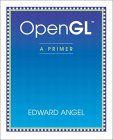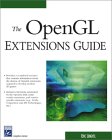
by Dave Shreiner (Author), Opengl Architecture Review Board
The OpenGL Programming Guide, now in its third edition, is the definitive volume for programmers using this evolving graphics interface standard. Written by members of the OpenGL Architecture Review Board, this book offers understandable tutorials and lessons on getting up to speed and getting the most out of the latest version of OpenGL, version 1.2. The guide uses code examples in C and is targeted at programmers who have experience in coding yet are new to coding for OpenGL applications. The opening chapters go into descriptive detail of how OpenGL, the software interface for hardware 3-D chipsets, works and what you can expect from it, which turns out to be much more than you might have thought. Color plates are used, for example, to show how OpenGL handles such effects as motion blur and depth-of-field blur, in addition to shadows and texture mapping.

by Dave Astle, Kevin Hawkins, Andre LaMothe
OpenGL is an application programming interface (API) that exposes hardware features needed to create computer graphics. Unlike Microsoft's Direct3D, which only works on Windows, OpenGL works across all platforms. OpenGL Game Programming is a complete guide to game development using the OpenGL graphics API. Myriad examples are included to demonstrate various concepts such as coloring, texture mapping, blending, lighting, coordinate transforms, 3D modeling, collision detection, and several other key concepts involved in game development. It also covers how to integrate the non-graphical elements of Microsoft's DirectX into OpenGL games so that users can incorporate sound, music, and networking functions. Teaching users how to use OpenGL to create dynamic 3D environments and effects for use in game development, this book covers all the fundamentals so that users can program OpenGL API to its fullest potential. Anyone interested in game development will find the information in this book invaluable as they begin to create dynamic game graphics. Series editor André LaMothe has published numerous magazine articles and is an international best-selling author with over six game programming and 3D graphics titles to his credit. He has been active in the computing industry for more than twenty years, during which he created one of the world's first commercially available virtual reality games, CyberGate. André is also the founder and CEO of Xtreme Games LLC.

by Donald Hearn, M. Pauline Baker
Reflecting the rapid expansion of the use of computer graphics and of C++ as a programming language of choice for implementation, this book converts all programming code into the C++ language. This new edition is a complete revision, bringing the text up to date with current advances in computer graphics technology and applications. Assuming readers have no prior familiarity with computer graphics, the authors—both authorities in their field—present basic principles for design, use, and understanding of computer graphics systems using their well-known, and accessible writing style. It includes an exploration of GL, PHIGS, PHIGS+, GKS and other graphics libraries and covers topics such as distributed ray tracing, radiosity, physically based modeling, particle systems, and visualization techniques. For professionals in any area of computer graphics: CAD, Animation, Software Design, etc.

by Edward Angel
This book teaches beginners how to create interesting computer graphics. It takes a top-down approach that starts readers creating interesting computer graphics from the start using OpenGL. Interactive Computer Graphics, 3/e features a top-down, programming-oriented approach to computer graphics. Capitalizing upon this top-down and hands-on approach, the text quickly gets readers writing interesting 3D graphics programs. Angel uses OpenGL, a graphics library supported by most workstations, as well as the C and C++ programming languages, allowing readers to be aware of what is happening at the lowest levels of computer-graphics programming. This revision includes extensive 2-color art and graphics to bring important concepts to life. This book is ideal for programmers looking for a hands-on introduction to computer-graphics programming that allows them to start writing 3D graphics programs early on.

by Edward Angel
Ed Angel provides an introduction to basic OpenGL 1.2 commands in a non-mathematical manner that covers the "how to" and gets readers programming quickly with OpenGL. This primer offers complete coverage of a subset of the OpenGL Application Programmers Interface (API). Case studies apply the commands and examples introduced in each chapter. A discussion of common pitfalls is also included in every chapter. Ten chapters cover: an introduction; two-dimensional programs; interaction and animation; three-dimensional programs; transformations; lights and materials; bits and pixels; texture mapping; curves and surfaces; and some advanced features of OpenGL. This concise introduction to OpenGL 1.2 is ideal for those looking to program computer graphics using OpenGL. It succeeds both as a companion to a book introducing computer graphics principles, and as a stand-alone beginners guide to OpenGL for programmers with a background in computer graphics.

by Eric Lengyel
OpenGL is the premier environment for developing 2D and 3D graphics and game applications. The interface has been the choice of game programmers, primarily because of its cross-platform operability, but also, because it is constantly evolving to keep pace with hardware advances in the form of extensions. Until now, the game industry was lacking one single, concise reference to help make sense of the dozens of extensions available. The OpenGL Extensions Guide provides a valuable resource that concentrates specifically on the extensions most important to developing modern 3D games. The book describes extensions in groups that modify or augment similar components of the base OpenGL architecture.

by Samuel R. Buss
This introduction to 3D computer graphics emphasizes fundamentals and the mathematics underlying computer graphics, while also covering programming techniques using OpenGL, a platform-independent graphics programming environment. The minimal prerequisites make it suitable for self-study or for use as an advanced undergraduate or introductory graduate text as the author leads step-by-step from the basics of transformations to advanced topics such as animations and kinematics. Accompanying software, including source code for a ray tracing software package, is available freely from the book's web site.

by Chris Seddon
to be published in March 2004
by OpenGL Architecture Review Board, Mason Woo, Jackie Neider, Tom Davis, Dave Shreiner, OpenGL® Architecture Review Board
OpenGL is a powerful software interface used to produce high-quality, computer-generated images and interactive graphics. This boxed set contains "OpenGL Programmers Guide, 3rd Edition", and the "OpenGL Reference Manual, 3rd Edition"

by Francis S. Hill
New edition of an introduction to computer graphics for students who wish to learn the basic principles and techniques of the field and want to write substantial graphics applications themselves. With an emphasis upon 3D computer graphics, Hill (electrical and computer engineering, U. of Massachusetts) shows how to translate a particular design task first into its underlying geometric components, to find a suitable mathematical representation for the objects involved, and finally to translate this representation into suitable algorithms and program codes.

by Mason Woo, Jackie Neider, Tom Davis, Dave Shreiner, OpenGL Architecture Review Board
The OpenGL Programming Guide, now in its third edition, is the definitive volume for programmers using this evolving graphics interface standard. Written by members of the OpenGL Architecture Review Board, this book offers understandable tutorials and lessons on getting up to speed and getting the most out of the latest version of OpenGL, version 1.2. The guide uses code examples in C and is targeted at programmers who have experience in coding yet are new to coding for OpenGL applications. The opening chapters go into descriptive detail of how OpenGL, the software interface for hardware 3-D chipsets, works and what you can expect from it, which turns out to be much more than you might have thought. Color plates are used, for example, to show how OpenGL handles such effects as motion blur and depth-of-field blur, in addition to shadows and texture mapping. This is not a beginner's guide to programming computer graphics. Some previous knowledge of both programming in general and computer graphics in particular is required. For example, code snippets are used to describe how to implement these effects, but because OpenGL is platform-independent, some code examples may need to be modified when used with your specific compiler.

byRichard S. Wright Jr., Michael R. Sweet
The OpenGL SuperBible lives up to its name: nearly 700 pages of examples, function descriptions, and code snippets for the Windows-based programmer trying to get up to speed on coding OpenGL graphics. This new edition has been revised and updated to include OpenGL 1.2, which offers more features and tighter integration with hardware accelerators than any earlier version. Sections are logically broken down into graphics fundamentals and an introduction to OpenGL, the "Meat and Potatoes" of OpenGL rendering, and the specifics of OpenGL programming for Windows. Long on examples and function descriptions, the book is a bit short on pictures, color plates, and screen shots. However, the accompanying CD-ROM has all the examples used in the book, some other exciting examples of OpenGL programming (the flight simulator with the terrain generator is remarkably smooth, for example), and the OpenGL library toolkits (GLUT 3.7, MESA 3, ZLIB 1.1.3, and others). It doesn't contain, however, a searchable electronic version of the book, which would have been very valuable given its complexity. But the book is thorough, and it covers every aspect of OpenGL programming, making it a good reference for anyone who codes for graphics applications, in spite of its shortcomings. Mike Caputo